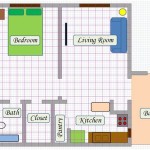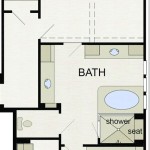Tile Floor Trim in Bathroom Design: Functionality and Aesthetics
Bathroom tile floors offer a durable and visually appealing surface, but to achieve a complete and professional finish, the inclusion of appropriate trim is crucial. Tile floor trim in a bathroom serves both functional and aesthetic purposes, protecting edges, transitioning between surfaces, and enhancing the overall design. Selecting the right trim requires careful consideration of material, style, and installation techniques to ensure a long-lasting and visually cohesive result.
Key Functions of Bathroom Tile Floor Trim
The primary role of tile floor trim is to protect the exposed edges of the tile. Without trim, these edges are vulnerable to chipping, cracking, and general wear and tear. This is particularly important in high-traffic areas and where the tile meets walls, doorways, or other flooring materials.
Another critical function is creating a smooth transition between different surfaces. Bathrooms often feature a combination of flooring materials, such as tile and vinyl. Trim pieces bridge the gap between these materials, preventing tripping hazards and providing a neat, finished look. This transition also prevents water from seeping underneath the flooring, which could lead to mold and mildew growth.
Furthermore, trim contributes significantly to the overall aesthetics of the bathroom. The correct trim can complement the tile color and pattern, enhancing the design scheme. A wide variety of trim options are available in different materials, colors, and styles, allowing homeowners to customize the look to their specific preferences.
Types of Bathroom Tile Floor Trim
Several types of trim are commonly used for tile floors in bathrooms, each with its own advantages and applications. Understanding these options allows for informed decisions based on the specific needs of the project.
Bullnose Trim: Bullnose trim features a rounded edge, providing a smooth and safe transition. It is often used along the edge of the floor where it meets the wall or around a shower base. The rounded edge minimizes sharp corners, making it a suitable choice for bathrooms where safety is a concern.
Quarter Round Trim: Quarter round trim is a convex molding that is also used to conceal gaps and create a finished edge. It is smaller than bullnose trim and can be made of various materials, including ceramic, porcelain, or vinyl. Often used to cover the expansion gap between the tile and the wall, this type of trim helps to prevent moisture from seeping behind the tile.
Schluter Trim: Schluter trim is a metal profile designed to protect tile edges and create a clean, modern look. It comes in a variety of shapes and finishes, including aluminum, stainless steel, and brass. Schluter trim is particularly useful for creating transitions between different flooring materials and for protecting the edges of tile in high-traffic areas. It’s designed to be integrated during the tile setting process, ensuring a flush and secure installation.
Cove Base Trim: Cove base trim is a type of trim that curves upwards from the floor to the wall, creating a seamless transition. This type of trim is often used for commercial applications, but it can also be used in bathrooms to provide a hygienic and easy-to-clean surface. Cove base trim is typically made of vinyl or rubber and is available in a variety of colors.
Pencil Trim: Pencil trim is a thin, decorative trim piece that can add a touch of elegance to a tile floor. It is often used as a border around a tile design or to separate different tile colors. Pencil trim is available in a variety of materials, including ceramic, glass, and metal.
Thresholds: Thresholds are used to create a smooth transition between two different flooring materials, such as tile and carpet. They are typically made of metal, wood, or stone and are available in a variety of styles and finishes. Thresholds are essential for preventing tripping hazards and creating a safe and accessible bathroom.
Considerations for Selecting Bathroom Tile Floor Trim
Choosing the right tile floor trim involves several factors, including the material, style, and installation method. Careful consideration of these aspects ensures a durable and aesthetically pleasing outcome.
Material Compatibility: The trim material should be compatible with the type of tile used in the bathroom. For example, if the floor is made of porcelain tile, using porcelain trim is generally recommended due to similar properties regarding water resistance and durability. Mixing materials with significantly different expansion rates can lead to cracking and other issues over time.
Style and Aesthetic Harmony: The style of the trim should complement the overall design of the bathroom. Consider the color, pattern, and texture of the tile, as well as the other fixtures and accessories in the room. A minimalist bathroom might benefit from sleek, metal Schluter trim, while a more traditional bathroom might be better suited to bullnose or quarter round trim made of ceramic or porcelain.
Water Resistance: Bathrooms are inherently wet environments, so the trim material must be water-resistant. Ceramic, porcelain, vinyl, and certain types of metal are all suitable choices. Avoid using wood trim in areas that are frequently exposed to water, as it can warp and rot over time. Consider using waterproof membranes or sealants to further protect the subfloor around the perimeter of the room.
Budget: The cost of tile floor trim can vary widely depending on the material, style, and manufacturer. Before starting the project, establish a budget and research different options within that range. Remember to factor in the cost of installation materials, such as thin-set mortar and grout.
Ease of Installation: Some types of trim are easier to install than others. For example, self-adhesive trim is relatively simple to install, while Schluter trim requires more specialized tools and techniques. Consider the level of DIY experience and the complexity of the project when selecting trim. If unsure, professional installation is always recommended.
Maintenance: Different trim materials require different levels of maintenance. Ceramic and porcelain trim are easy to clean and maintain, while metal trim may require occasional polishing to prevent tarnishing. Vinyl and rubber trim may need to be periodically replaced if they become damaged or discolored.
Installation Techniques for Bathroom Tile Floor Trim
Proper installation is essential for ensuring the longevity and effectiveness of tile floor trim. Whether installing it personally or hiring a professional, recognizing the core techniques can help achieve a successful outcome.
Preparation: Before starting the installation, ensure that the subfloor is clean, level, and dry. Remove any debris, dust, or old adhesive. If the subfloor is uneven, use a self-leveling compound to create a smooth surface. This is crucial for ensuring that the trim sits flush and provides a secure transition.
Cutting and Fitting: Carefully measure and cut the trim to the correct length. Use a wet saw or tile cutter to make precise cuts. When cutting trim with a miter saw, ensure that the blade is appropriate for the material being cut to prevent chipping or cracking. Dry-fit the trim pieces to ensure that they fit properly before applying adhesive.
Adhesive Application: Apply a thin, even layer of thin-set mortar or construction adhesive to the back of the trim piece. Press the trim firmly into place, ensuring that it is aligned correctly. Use spacers to maintain consistent grout lines between the trim and the tile. Remove any excess adhesive with a damp sponge.
Grouting and Sealing: Once the adhesive has dried, grout the joints between the trim and the tile. Choose a grout color that complements the tile and trim. Apply grout sealer to protect the grout from moisture and stains. Allow the sealer to dry completely before using the bathroom.
Special Considerations for Schluter Trim: Schluter trim is typically installed during the tile setting process. The trim profile is embedded in the thin-set mortar along with the tile. Ensure that the trim is flush with the tile surface and that the mortar is properly compacted around the profile. Follow the manufacturer's instructions for specific installation details.
Addressing Corners: For inside and outside corners, pre-fabricated corner pieces are often available for certain trim types which provide a clean, professional finish. Alternatively, miter the trim pieces at a 45-degree angle to create a seamless corner. Ensure that the mitered edges are precisely cut and aligned. Use a small amount of adhesive to secure the corner pieces.
Waterproofing: In areas that are frequently exposed to water, such as around the shower or bathtub, apply a waterproof sealant along the seam between the trim and the tile. This will help to prevent water from seeping behind the tile and causing damage. Reapply the sealant as needed to maintain its effectiveness.
Selecting and installing the appropriate tile floor trim in a bathroom is an essential aspect of a successful tiling project. By considering the functions, types, material properties, and installation techniques, a bathroom can have long lasting beauty and practicality.

13 Best Tile Baseboard Ideas Bathroom Baseboards

Tile Skirting Vs Wood Baseboard Molding Nomadic Decorator

How To Install Baseboards Trim In A Bathroom Renovation Young House Love

Subway Tile Bathroom Baseboards Design Ideas

Tile Edge Trim Selection And Installation Tips From A Pro

Bathroom Floor And Trim Project Of The Day Odd Job Larry

Subway Tile Baseboards Design Ideas

Adding Custom Trim During The Bathroom Remodel

28 Baseboard Trim Ideas To Match Your Stylish Tile Floors

How To Install Baseboards Trim In A Bathroom Renovation Young House Love







